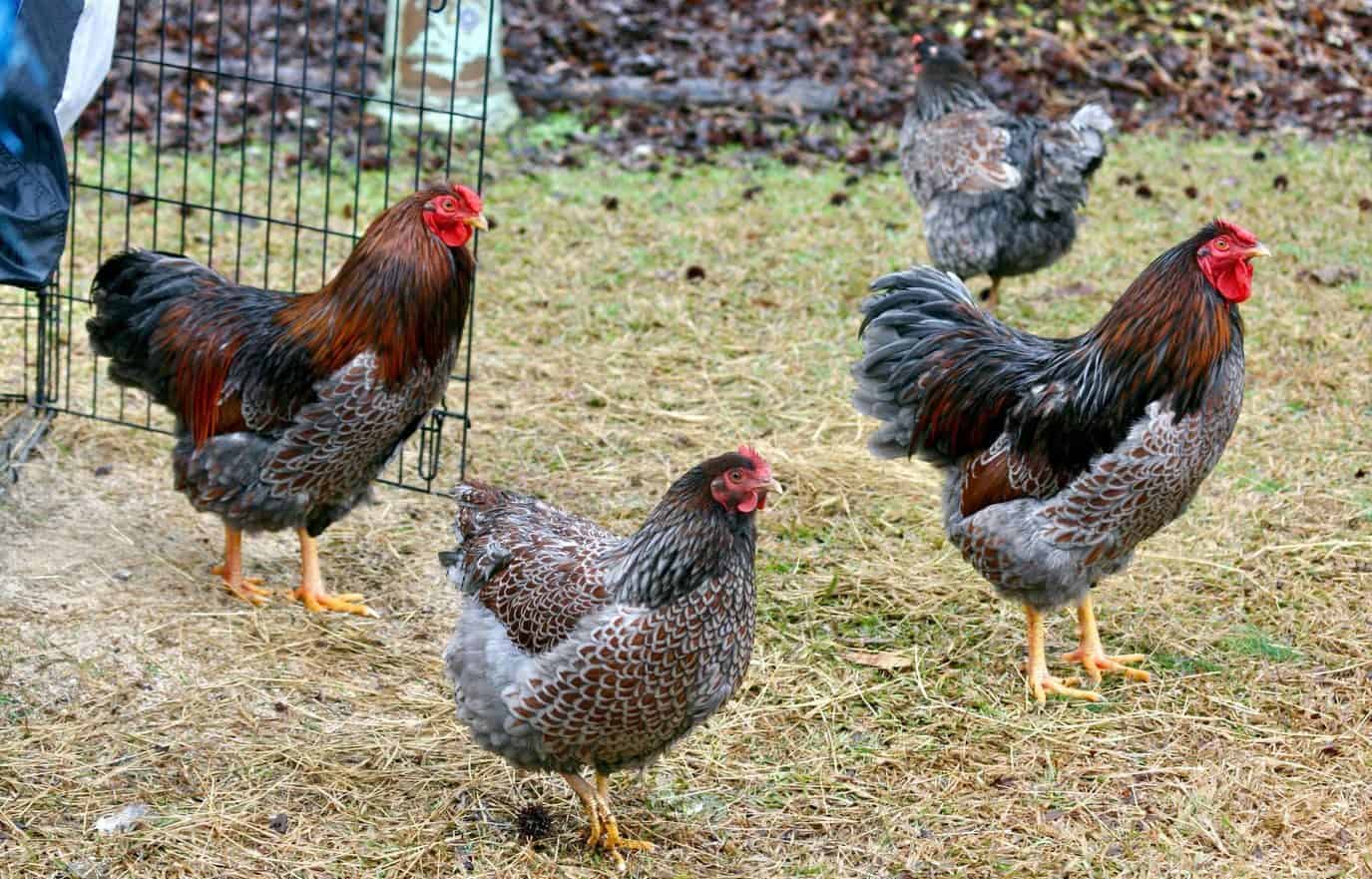With eye-catching, unusual plumage, the Blue Laced Red Wyandotte is a lovely chicken who has more going for it than just the fancy color pattern. These large birds have much to offer to the backyard hen keeper or someone who raises hens to sell eggs at the farmer’s market.
They are cold hardy, making them ideal for a steady supply of eggs in the colder months.
If you are looking for a friendly chicken that will earn its keep, you may want to try the Blue Laced Red Wyandotte.
Breed History and Overview
Wyandotte chickens are an all-American breed, created back in the 1870s. The men who worked together to create this breed lived in extreme northern New York State and southern Canada.
In the beginning, the breeders called this breed of chicken an American Sebright. Later, the chicken breed was named Wyandotte, after the Native American tribe of the same name that inhabited the area of its origins.
Exact records do not exist that detail which birds were used in making this new breed of bird, but most poultry historians think that silver spangled Hamburgs and Dark Brahmas were important breeds used in the creation of this breed.
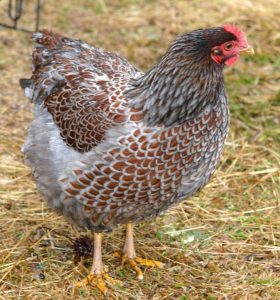
Wyandottes
Initially, the Wyandotte came in a silver laced color pattern, but over the years, chicken breeders have used other chicken breeds to make new and beautiful colors, like the silver laced version, the black, the buff, and the golden laced Wyandotte, among others.
One of the most eye catching colored Wyandottes is the Blue Laced Red Wyandotte. This kind of bird is not officially a breed yet, but it is getting more popular all the time, and breeders are hopeful that American poultry breed associations will soon recognize it as a new breed of chicken.
While the history of the breed is a bit murky, some believe that American breeders created the first version of the Blue Laced Red Wyandotte by breeding golden laced Wyandottes to Blue Andalusian chickens.
These birds had some of the unique color patterns of the Blue Andalusian, but it kept most of the delightful traits of the classic Wyandotte chicken. Poultry buyers exported the original birds to the United Kingdom.
In the 1920s, German breeders received some of these birds from breeders in the United Kingdom, and they further perfected the breed. In 1929, the birds were exhibited in a Poultry Show in Leipzig, Germany.
Not long afterward, the Blue Laced Red Wyandotte was admitted into the German Standard of Perfection. It wasn’t long before American breeders began importing the refined version of these birds and breeding the chickens themselves.
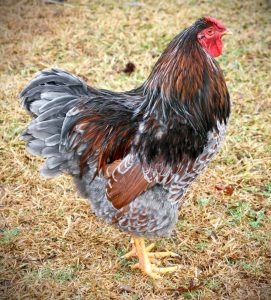
Blue Laced Red Wyandotte
The Blue Laced Red Wyandotte has flashy good looks. They are beautiful chickens. The birds have deep mahogany red feathers with blue lacing. The blue color in the feathers may be a light blue or a darker blue.
Lacing on a chicken means that each feather has a main color, in this case a dark red, and around the outer rim of the feather is a different color, in this case blue. This gives the bird a lovely speckled appearance.
Blue Laced Red Wyandotte chickens have clean legs and rose combs.
Some people may market Blue Laced Red Wyandottes with single combs, but poultry breeding associations prefer that breeders not use single combs for breeding this bird. They say that the single combs are associated with health problems that breeders want to avoid.
The body shape of the Blue Laced Red Wyandotte should follow the standard set by traditional Wyandottes. They have deep bodies and plenty of curves. The back of the bird should have a gentle U-shape.
They should have short, sturdy legs. They have yellow feet and beaks with red combs, wattles, and earlobes. Their eyes are a reddish bay color.
They are called Blue Laced in the UK.
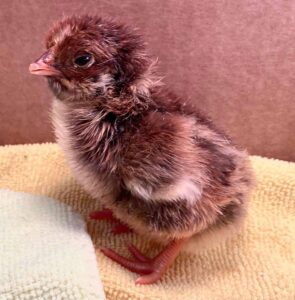
Sexing Chicks
You can sex Blue Laced Red Wyandotte chicks when they are 8 weeks old or older. Cockerels will have larger and redder combs than females. As far as body frame, the pullets will be less wide than cockerels. Females won’t appear as sturdy as the males.
Weight
Blue Laced Red Wyandotte roosters generally weigh in at about 8 to 9 pounds, and the hens weigh between 6 and 7 pounds. These birds might appear larger than this, but mostly that is due to the abundance of feathers on the bird.
Bantam roosters weigh 1.8 – 2 pounds while bantam hens weigh 1.6 pounds
Benefits to Raising
Blue Laced Red Wyandottes were created, like the original Wyandotte breed, to be a healthy dual-purpose chicken.
Egg Production and Meat
The roosters are large enough to make it worthwhile to dress out for dinner, while Blue Laced Red Wyandotte hens are considered moderate layers, giving you about 4 eggs per week or roughly 200 eggs per year.
The eggs are medium to large sized. Blue Laced Red Wyandotte eggs can vary in color from a light tan to a deep brown. The color hens lay depends on the strain of chicken that you have. They are among the best egg laying chickens.
Temperament
They are friendly chickens with curious, interesting personalities. They make excellent pet chickens. This makes them good for those who have small children.
Typically, they don’t mind when people handle them, especially if you start handling them when they are young. However, they aren’t considered lap chickens.
Their personalities are rather mellow, so if you have more aggressive breeds, keep an eye on your flock. Blue Laced Red Wyandotte hens might end up being bullied by more aggressive breeds in a mixed flock, or they may not get their fair share of food and water. Keep plenty of waterers and areas with food.
They are good foragers, suitable for free ranging which will help with pest management. On the flip side, they don’t mind confinement, as long as there is adequate space in the chicken run. Keep them entertained and stimulated. Be sure to provide fresh grass and chicken toys if they will only remain in the run.
They are noisy, chatty and vocal. They are not quiet chickens. If you have nearby neighbors, consider their proximity. Their noise level is considered moderate to high. If you live in a rural area, they are ideal.
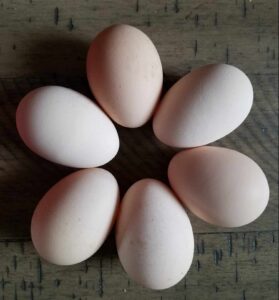
Blue Laced Red Wyandotte Rooster Temperament
In general, Blue Laced Red Wyandotte roosters aren’t overly aggressive. They will be loyal to their flock, tend to them, and protect them. They are somewhat friendly as far as roosters are concerned. However, their temperament varies by rooster. You can choose to use it for meat if it’s too aggressive.
Do not mix groups of roosters without special care.
Cold Hardiness
These chickens tolerate cold weather very well with their heavy bodies and liberal, dense feathering. Their down helps them insulate in the cold.
Their rose combs are less likely to get frostbite in very cold weather because they are somewhat flat. The combs fit closely against their heads, making them a great choice for those who raise chickens in cold climates.
Broodiness
If you are looking for a hen that makes an excellent mother, you may want to have a few Blue Laced Red Wyandotte in your flock. These hens go broody fairly often, and they make protective mothers after hatching out a clutch of eggs.
If you want a hen that is more or less likely to go broody, you should check with your hatchery. Some family lines are more likely to go broody, while others are more consistent layers.
Growth Rate
These chickens do grow fairly quickly, especially being a heritage breed. While they don’t compete with a Cornish cross for meat, they can be of a respectable size for table meat by the time they are 16 to 20 weeks old. The hens are about 20 weeks old when they begin laying eggs. They provide a good return on investment compared to some other breeds which are slower growing.
Beautiful Chickens
They’re also simply stunning to look at. The blue gene will color the chicks either light blue or dark blue in the lacing in the baby chicks and the mature chickens.
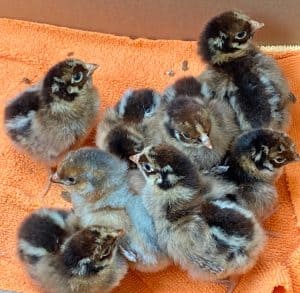
Blue Laced Red Wyandotte Care Guide
When raising backyard chickens, your job is to keep all the chickens safe, healthy, and stress-free.
Feeding
Like every breed of chicken, Blue Laced Red Wyandottes need good layer pellets and clean water at all times. They are omnivores so give them access to insects, fruits, vegetables as well.
A diet for healthy laying hens should contain crushed oyster shell for egg production and grit for digestion. An average, a 6 pound hen will eat approximately 3 pounds of feed each week.
Some scratch-cracked corn and oats are a nice treat on occasion but they don’t supply all their nutritional needs. They are fine in moderation.
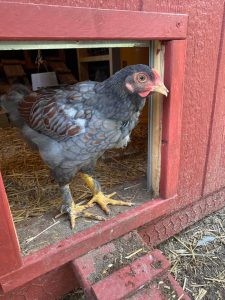
Space and Shelter
They also need an enclosed hen house or chicken coop that is secure from predators. It should have chicken nesting boxes and perches. Install the perches higher than the nesting boxes so they’ll use them to roost. It will also help keep them safe from predators.
Be sure to have enough space for the chickens. They’ll do best with a minimum of four square feet per chicken because they are large chickens.
Giving chickens more space as well as having plenty of feeders and waterers will help maintain a stress free environment. This will minimize picking and cannibalism.
If you’re keeping them in a chicken run without the option to free range, be sure to keep it interesting. If possible, move the run to different areas on your property. Have room for chicken toys and supply the chickens with fresh grasses.
Heat
One thing to remember is that these birds were bred in very cold areas of the country. While they can tolerate some heat, if you live in an area with very hot summers, choose a different breed or keep a close eye on your chickens when it gets hot.
Combs on chickens help them regulate their body temperatures in hot weather. Because their combs are very small and close to their heads, they don’t keep them cool in hot weather.
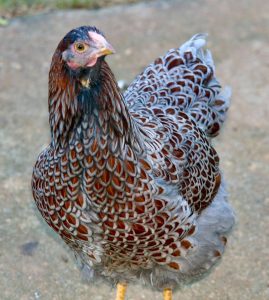
On occasional warm days in the summer, make sure that your chickens have a well-ventilated hen house. They require plenty of shade in the barnyard. Continual access to clean, fresh water is essential. Chickens cool themselves by panting.
You may even want to install a fan in your chicken house to prevent heat stress in your Blue Laced Red Wyandottes.
Maintenance and Health
The liberal feathering of the Blue Laced Red Wyandotte is beautiful with their blue lacing but may present some minor problems. If you are using your hens for breeding, you may need to trim the fluffy feathers around their bottoms to facilitate mating. Additionally, the feathers on their bottoms may end up coated in feces, so you may want to keep this area trimmed.
If keeping a Blue Laced Red Wyandotte rooster or other rooster, be sure to keep a minimum of 8 – 10 hens per rooster.
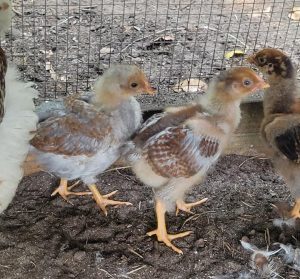
FAQ’s
Are Blue Laced Red Wyandottes Good Layers?
Yes, they are good layers. They are cold hardy and lay reliably throughout the colder months. This makes them an ideal chicken to have a steady supply of eggs all year.
What Color Eggs Do Blue Laced Red Wyandottes Lay?
These chickens lay brown eggs. They will vary in shade from light brown to dark brown.
Are Blue Laced Red Wyandottes Rare?
These blue chickens with their deep red and mahogany coloring can be difficult to find. They do not breed true so you’ll need to find them from specialty breeders.
They are beautiful AND earn their keep by providing eggs and meat. Because they are so productive, useful and unique, they are more expensive than many other chicks and chickens. Chicks will cost $30+. Females may cost more.
Are Blue Laced Red Wyandotte Roosters Aggressive?
Wyandotte roosters will fiercely protect their flock by alerting them to danger but they aren’t considered aggressive roosters. Each will have a different temperament and personality, however. You may consider using it for meat if it’s too aggressive.
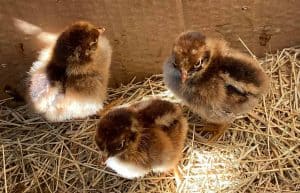
Conclusion
With their beautiful feathers and friendly dispositions, Blue Laced Red Wyandotte chickens are easy-going. They’ll do well with other Wyandotte chickens, such as a Silver Laced Wyandotte or Golden Laced Wyandotte, or in a mixed flock with other mild-mannered, less aggressive chickens. Introduce new birds slowly and carefully. Watch for the pecking order and ensure all the birds are safe.
They are a good choice for beginners and experienced chicken owners.
Being dual-purpose, they make a great addition to backyard hobby farms. Wyandottes are among the best chicken breeds to raise. They are excellent layers and will provide a reliable supply of brown eggs. You can also raise them for a meat source or use them for meat once their egg-laying has diminished.
Do not choose them if you live in a hot climate or an area with consistently hot summers. They are suited to areas with cold winters. They have poor-to-moderate tolerance for heat.

